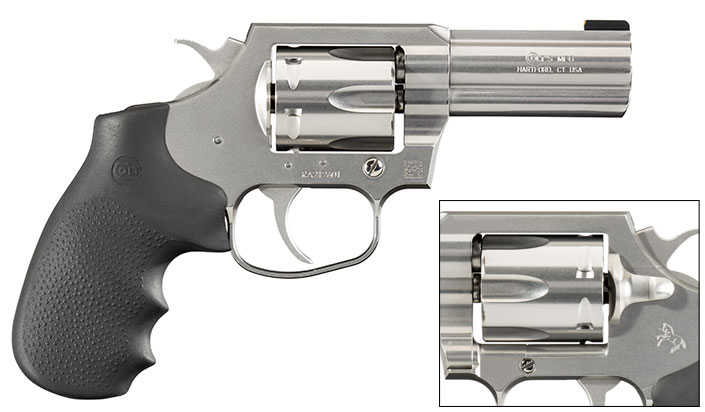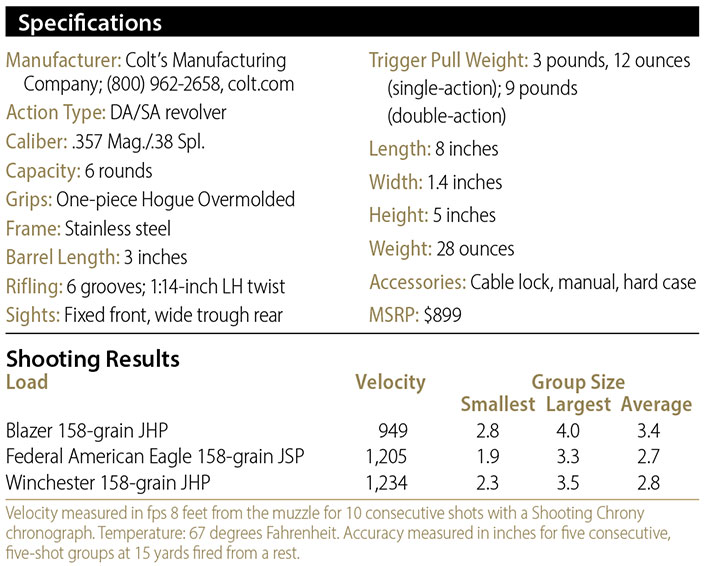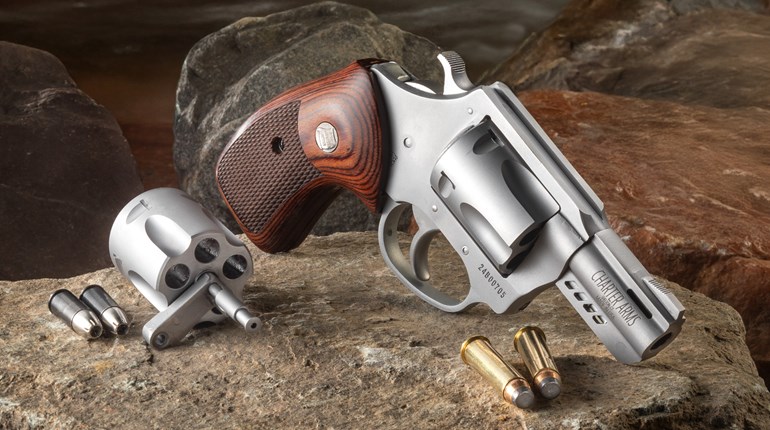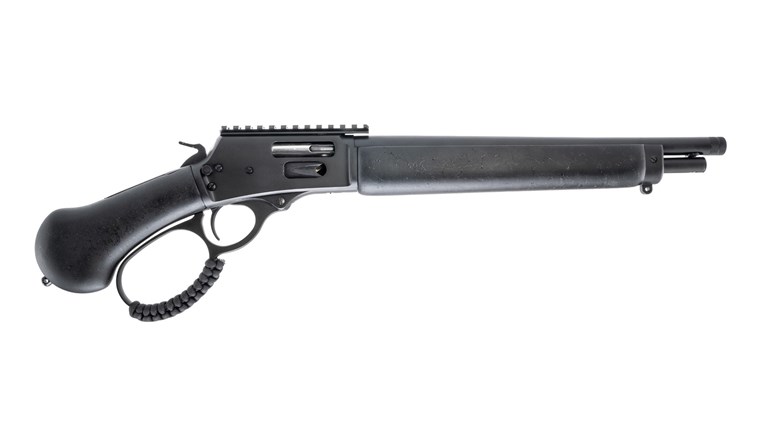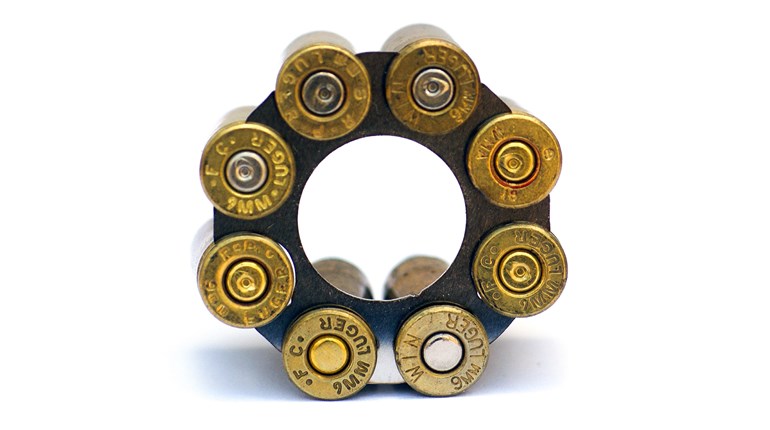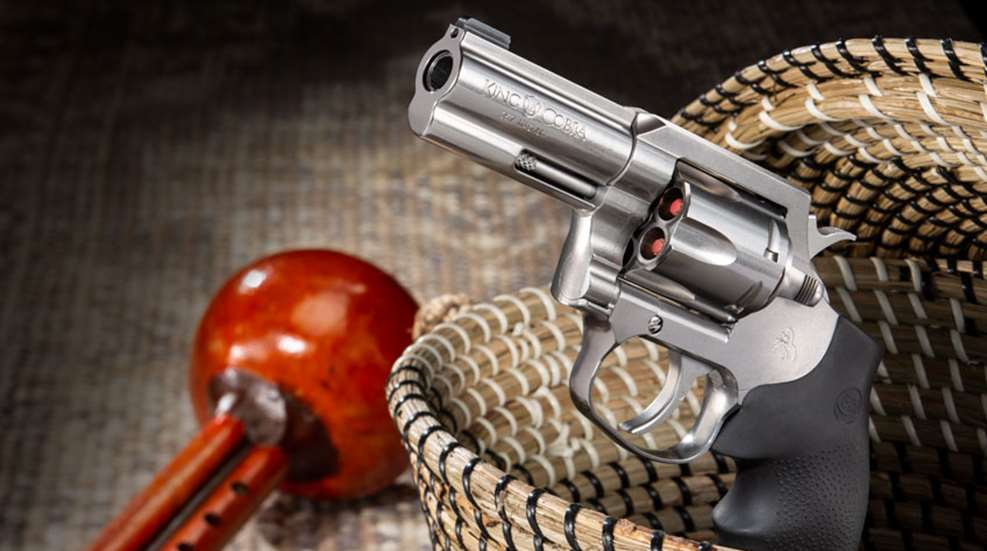
Despite being a longtime revolver fan, I always experience some trepidation accepting writing assignments to review small, lightweight, magnum revolvers. Simply put, heavy recoil inflicts a lot more punishment on the shooter than a missed shot inflicts on the attacker, and heavy recoil can definitely cause misses.
Colt’s King Cobra in .357 Mag. offers some interesting solutions to this dilemma. Specifically, the frame is stainless steel instead of alloy or polymer, the grip frame is surrounded by a one-piece Hogue molded grip and the stainless steel barrel (with its integral lug) has been extended by an extra inch, thus adding a couple of ounces at the muzzle and bringing the gun’s total weight up to a reasonable 28 ounces. These are old-school, recoil-taming techniques that make the .357 Mag. less formidable to shoot and more formidable to any threat you may have to face.
The first thing that grabbed me about the King Cobra was the feel of the Hogue grip; It fits me perfectly. Three finger groves position the knuckle of my middle finger such that it is not hammered by the recoil of heavy 158-grain loads. The molded stippling on the grip is enough to maintain purchase during recoil without being overly aggressive. Rubber covers just enough of the backstrap to help soften recoil while allowing perfect placement of my trigger finger on the trigger to effect a smooth and controlled double-action pull. The grip is large enough to enhance control of the gun and offer some protection from recoil—without adding so much bulk that concealment becomes a concern.
Trigger pull is quite smooth, with the weight increasing just enough before hammer release to let you know you’re getting close, but not enough to cause the dreaded trigger jerk. The trigger is relatively thin (about 1⁄8-inch wide) and has a smooth face allowing the trigger finger to slide slightly across its surface without moving the gun out of alignment. With its external hammer, the King Cobra can be fired single-action.
(Side note: When shooting the King Cobra single-action, consider cocking the hammer with the thumb of your support hand. There is a small shelf on the top of the Hogue grip that extends about a quarter inch behind the frame. When cocking the gun with my shooting hand, my thumb touched the shelf before the hammer locked back, which made me think the gun was fully cocked and locked. When cocking with the support-hand thumb, the hammer locked in place before the thumb touched the shelf. No big thing.)

The sights are entirely appropriate for a defensive handgun; extremely rugged and quick to acquire. The rear sight is a wide trough with vertical side walls machined into the frame’s thick topstrap. Can’t get much more rugged than that. The front sight is a blade inserted into a slot at the gun’s muzzle and secured by a recessed setscrew. It’s easily removed and replaced should you desire. There is a brass bead in the rear-facing surface of the blade that demands your attention when the gun is brought to eye level. It’s actually difficult not to see and focus on the bead. When the bead is placed on the target and surrounded by the rear notch, press the trigger. Combined with the superb-fitting Hogue grip, aligning the Cobra’s sights seemed almost instinctual.

I’m not a fan of the cylinder-release latch on Colt’s double-action revolvers. Reaching around the back of the latch with the thumb of my shooting hand meant totally surrendering my firing grip in order to reload. If I’m reloading all chambers with a speedloader, that’s OK, because the gun is useless while it’s empty. If I’m topping off with two or three rounds during a lull in the action, I like to reload with my support hand and maintain my firing grip.
Should the action suddenly resume, I can slap the cylinder shut and be back in the fight with whatever rounds remain in the gun. An easy way for right-handed shooters to operate Colt cylinder-release latches is to hook the forefinger of your support hand around the latch from the top and pull it toward you. Simultaneously slide your trigger finger up the frame and press against the side of the cylinder until the cylinder pops out. Remain aware of your surroundings as you reload.
A brief note on the rotation of revolver cylinders: a Colt rotates clockwise as viewed by the shooter, rather than counter clockwise like a Smith & Wesson. Position of cylinder doesn’t matter when the gun runs dry and all chambers have been fully reloaded. But, if you are forced back into action with some chambers still empty, it’s best to close the cylinder with the first live round at 11 o’clock to ensure it rotates under the hammer instead of away from it on the first trigger pull. You don’t want to hear that dreaded click that occurs when the hammer falls on an empty chamber.
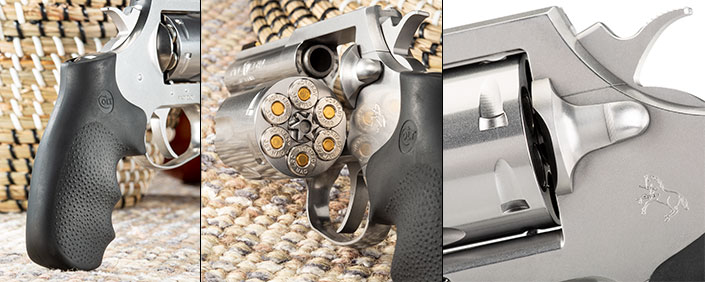
I had the King Cobra with me on a recent trip to Gunsite Academy, and while I didn’t get an opportunity to go through a training class, I did get some trigger time with Ken Campbell, Gunsite’s Chief Operating Officer. A quick tour of the Academy’s Fun House made me appreciate the natural pointing/aiming characteristics of the King Cobra and the enhanced visibility of the brass bead in the darker interior. The transition from bright Arizona sunlight to the unlit interior of a structure is a bit unnerving. Upon entry, I have a great deal of difficulty determining whether or not a potential threat is carrying a weapon or some harmless object. The Colt’s sight didn’t help identify threats, but it helped eliminate the threats once properly identified.
The outdoor Scrambler was considerably more difficult, with some of the targets located 100 yards or so downrange. The Colt’s sights were not designed to allow visual adjustments in elevation and windage for farther targets. It’s about seeing the threat, aiming the pistol and pressing the trigger as fast as you can make hits on target. It’s about dealing with threats inside 15-20 yards, which the range master in my last class called “the real world.”
Campbell and I did spend some time banging steel with .357 Mag. loads rather than .38 Spl. American Eagle and Winchester ammunition. At more than 1,200 fps it was invigorating, but controllable through a few cylinders. Neither of us would want to go through a full day’s training with it, but finishing a range session with a couple cylinders full of these loads wouldn’t be too hard on most experienced shooters, and it would put you back on the mean streets fully in tune with your gun and its ammunition. The Blazer 158-grain JHPs traveling in the mid-900 fps range and some hard-cast 158-grain SWC handloads in excess of 1,000 fps were more comfortable to shoot than the faster loads, but still present a formidable defense against any two-legged threat.
You can also feed the Colt either .357 Mag. or .38 Spl. ammo with lighter bullets (anywhere from 90- to 140-grain JHPs) to reduce recoil without surrendering performance. I chronographed some Super Vel .38 Spl. with 90-grain bullets and recorded a sizzling 1,338 fps. Reloading compact revolvers is a bit more reliable with .38 Spl. ammunition in terms of the shorter cases fully exiting the cylinder with a marginal stroke of the short ejection rod. You’ll have to decide your personal level of recoil tolerance and what works best for you, then determine if there’s any meaningful change in point-of-impact with alternate ammunition at typical defensive ranges, i.e. “the real world.”
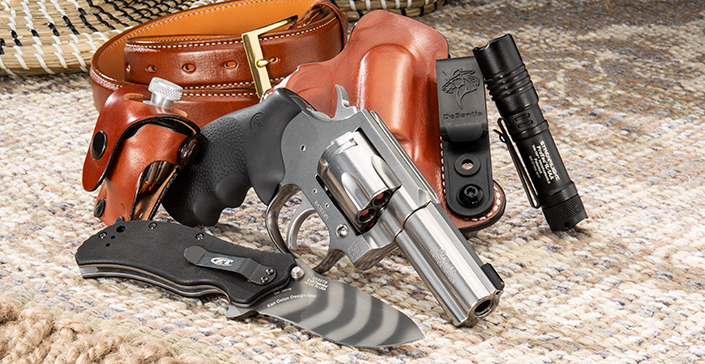
An obvious advantage of Colt’s newest .357 Mag. revolver is that it carries six rounds rather than the five normally associated with most short-barreled revolvers. More is better. We’ve also mentioned the extra inch of barrel and the gun’s hefty weight of 28 ounces. These are all good things in a revolver that you’ve purchased for self-defense—i.e. a gun you plan to shoot—but not so good for concealed carry. Overall size and weight take the King Cobra out of the pocket-pistol category for me, but it’s still suitable for strong-side concealed carry in a belt holster, whether it’s inside the waistband (IWB) or outside the waistband (OWB).
The latter requires a little longer shirt or jacket to completely conceal, while with IWB, the extra inch of barrel poses no additional discomfort and is completely concealed with only that portion of the grip frame extending above the belt needing coverage. It’s a trade-off only you can make: The comfort of having six rounds of full-power .357 Mag. that you can carry in relative comfort and shoot effectively versus fewer rounds of a lesser chambering in a gun that presents no carry or concealment difficulties. Paraphrasing Clint Smith, “Do you choose the one that’s comfortable, or the one that’s comforting?”
